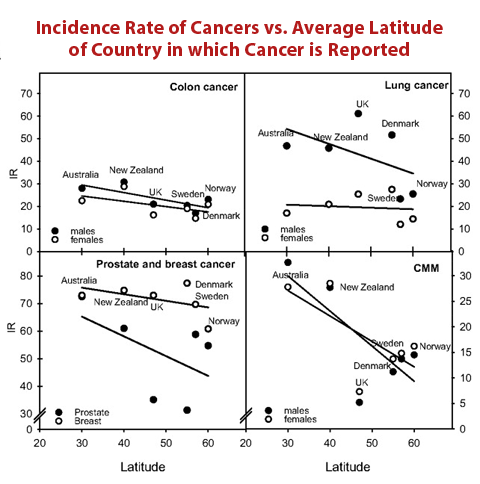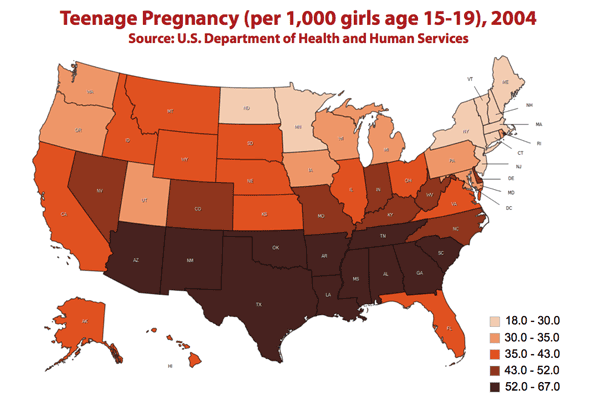Related article: Sunshine/light exposure as therapy

Table of Contents
Latitude studies on vitamin D and disease
The “latitude studies” are observational - as opposed to interventional - studies that use ambient solar UV radiation as a proxy for latitude and vitamin D status. For these studies, researchers compare rates of certain major cancers - most notably breast, colorectal and prostate cancer - to rates of sunlight exposure. This group of research has the liability of being wildly inconsistent. The choice to publish research on a specific latitude gradient may be a better proxy for a researcher's bias. There is sufficient variability in the prevalence of disease among countries and ethnicities that different researchers have come to different conclusions even those looking at the same data source.
The seeming randomness with which some countries have higher rates of disease than others suggests a different dynamic than the one proposed by the authors of the latitude/vitamin D studies. One provocative area for future research is to assess the relationship between per capita consumption of vitamin D as well as other immunosuppressants and disease. (No such statistics are publicly available.) Another potentially fruitful possibility is to model incidence of chronic disease as if it were a communicable infection.
Diabetes
Garland et al concluded on the basis of country-specific incidence rates of Type I diabetes that there is a correlation between a country's rate of diabetes and sun exposure.1) In his paper, Garland concluded that Type I diabetes could be prevented by consuming vitamin D or spending time in the noonday sun. As described by CBC News's Stephen Strauss, there are several weaknesses of this study.
First, Garland and team generated none of their own data, but instead had taken incidence levels collected around the world and first published by Karvonen et al in a 2000 paper.2) This may be immaterial except that the original paper did not make any mention of a latitude gradient.
Those who look at the data points for the study could probably surmise why not. According to the data, the world's highest rate of Type I diabetes is in sunny Sardinia, Italy. There are other inconsistencies.
Novosibirsk in Siberia…. had an incidence rate less than one-third that of Kuwait, two-and-a-half times lower than Puerto Rico, and below that of Sao Paolo and parts of Tunisia.
Huge disparities existed between what amounted to next-door neighbours. The rate in Puerto Rico was about 17.4 new cases yearly per 100,000 kids, but in Cuba the rate was 2.9 new cases.
Ethnicity made a monumental difference. No place in China had a high rate, even when you travelled to Harbin — which is north of most of Mongolia…. Nonetheless, Harbin's rate was less than a quarter that of Hong Kong, which is situated more than 2,800 kilometres to the south. Not to mention that the estimated rates in the Finnish paper for Sao Paolo were roughly the same as in Tierra del Fuego, some 5,000 kilometres to the south.
Stephen Strauss, Vitamin D and diabetes: An over-simplified solution to a complex problem
Strauss goes on to second-guess Garland's somewhat cavalier inclusion criteria. As opposed to the paper by Karvonen, which used incidence rates for boys and girls, Garland opts to use boys alone. Strauss's concludes that Garland discarded half his potential data set so that he might include a survey looking at rates of diabetes in boys living in Tierra del Fuego. The number of cases in that study: four.

Looking at Karvonen's original study, it is striking to consider that the countries with the world's highest rates of Type I diabetes (in order: Finland, Sweden, Canada, and Norway) also have relatively high rates of vitamin D supplementation. One Finnish study of children born in 1966 found that between 74 and 88% of mothers reported giving their children vitamin D supplements in the form of cod liver oil, typically.3)
Cancer
Main article: Vitamin D and cancer
A number of studies have suggested that sunlight exposure, and the resulting cutaneous synthesis of vitamin D, might have a beneficial influence for certain major cancers, most notably breast, colorectal and prostate cancer. These studies have been based either on using ambient solar UV radiation as a proxy for latitude in those studies looking at the geographical incidence and/or mortality of cancer, or case–control studies using questionnaires in which individuals are asked to recall previous sun exposure. However, this data is not consistent. There are any number of counterexamples in which there is an “inverse latitude gradient.”
Australia and New Zealand vs. Northern Europe
Multiple authors have cited what may be called the “Australia/New Zealand” paradox.4) In his 2006 review,5) Diffey cites “overwhelming evidence that people living in Australia and New Zealand are exposed to considerably more solar UV radiation than those living in northern Europe.” The annual ambient solar UV radiation in southern Australia and New Zealand is about two to three times that in northern Europe (United Kingdom, Ireland, Scandinavia and the Baltic States), rising to more than a fourfold increase in northern Australia. Further, studies of individual exposure to sunlight demonstrate that median doses in Australia are appreciably higher than those measured in a similar cohort of subjects in England.
In the review, Diffey points to epidemiological evidence, which clearly shows that the latitudinal gradient-cancer connection does not hold true at least among a large selection of countries containing large numbers of gentically related people with similar skin types, which is important for the photosynthesis of vitamin D.
Building on Diffey's work, Moan et al, summarize the epidemiological data for the “paradox”:
For some cancers, there may even be a significant inverse latitude gradient. Differences in sun exposure habits and skin types can probably not explain this observation because the inverse relationship remains when we use CMM [cutaneous malignant melanoma] incidence rates as a crude measure for real UV exposures. However, taking more countries into consideration, we see that no reliable north–south gradient can be extracted. There is a large variation of the incidence rates by factors of ≈50 and 5 for prostate cancer and breast cancer, respectively. Even for countries at the same latitude, large differences are found.
Moan et al.6)
United States
In the case of the gradient in different rates of cancer supposedly observed in the United States. Darrell S. Rigel, M.D, president of the American Academy for Dermatology has also argued consistently that no scientific studies exist which prove the statement that low low levels of light exposure lead to increases in cancers and other diseases:
The claim is based on a study that finds that overall cancer rates are higher in the northeast United States, a location with lower sunlight levels than many other places in the country. Those making this claim conclude that since the Northeast has lower UV levels, this is the reason why cancer rates are higher in this region. However, several studies prove this theory is false. These include studies which show that cancer rates are low in the Northern Plains states – areas of the United States that have lower UV levels then the states in the Northeast. Furthermore, several regional studies have shown that the increased levels of cancer observed in the Northeast states are tied to levels of industrial pollutants rather than levels of UV light.
Darrel S. Rigel, MD
Multiple sclerosis
The latitude at which people spend their youth up to the age of about 15 years correlates with later risk of multiple sclerosis, with people who grow up closer to the equator having a lesser risk of disease onset.7) While a number of commentators have blamed vitamin D deficiency, Bains has argued that near-horizon sunshine is at fault.8)
A common precursor for multiple sclerosis is optic neuritis or inflammationThe complex biological response of vascular tissues to harmful stimuli such as pathogens or damaged cells. It is a protective attempt by the organism to remove the injurious stimuli as well as initiate the healing process for the tissue. of the optic nerve. Optic neuritis can be caused by directly looking at the Sun, something that few people willingly do, but inadvertently happens in locations far from the Equator, in which the Sun is often close to the horizon.
In addition to optic neuritis, multiple sclerosis is correlated with several eye symptoms including diplopia (double vision), nystagmus (jerky eye movements), ocular dysmetria (overshooting eye movements), and internuclear opthalmoplegia (lack of coordination between the eyes).
Causation – the elusive grail of epidemiology
Main article: Mistaking correlation for causation in vitamin D studies
Some have argued that the apparent latitude gradient in disease prevalence speaks for itself, but one cannot impute causation simply by looking at a map. In 2003, L.R. Karhausen wrote a paper entitled “Causation: the elusive grail of epidemiology.” In the review, Karhausen rebukes those who would place undue faith in conclusions based on observational epidemiological studies.
Actually, there is no experience of causation: events do not wear their causal credentials on their faces.
L.R. Karhausen 9)
Without a precise understanding of underlying disease mechanisms, researchers could just as well conclude, for example, that sunshine exposure causes teenage pregnancy.

[PMID: 18548227] [DOI: 10.1007/s00125-008-1061-5]
[PMID: 11023146] [DOI: 10.2337/diacare.23.10.1516]
[PMID: 15699498] [DOI: 10.1196/annals.1337.013]
[PMID: 18180454] [PMCID: 2206594] [DOI: 10.1073/pnas.0710615105]
[PMID: 16704633] [DOI: 10.1111/j.1365-2133.2006.07268.x]
[PMID: 8180454] [DOI: 10.1002/jmri.1880040211]
[PMID: 10871801]
[PMID: 19906495] [DOI: 10.1016/j.mehy.2009.09.054]
[PMID: 11080970] [DOI: 10.1023/a:1009970730507]
[PMID: 20061416] [PMCID: 2841532] [DOI: 10.1210/jc.2009-1797]

